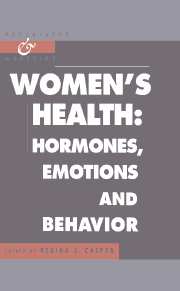Book contents
- Frontmatter
- Contents
- Preface
- 1 Growing up female
- 2 Reproduction and its psychopathology
- 3 Women's sexual function and dysfunction
- 4 Gender differences in brain morphology and in psychiatric disorders
- 5 Thyroid hormones in major depressive disorder and bipolar disorder
- 6 The hypothalamic-pituitary-adrenocortical system
- 7 The cost of starvation: Eating disorders
- 8 Coronary artery disease and women: Estrogens and psychosocial and lifestyle risk factors
- 9 The psychophysiology of breast cancer: Disease, hormones, immunity, and stress
- 10 The psychopharmacology of women
- 11 Intervention trials concerned with disease prevention in women
- References
- Index
8 - Coronary artery disease and women: Estrogens and psychosocial and lifestyle risk factors
Published online by Cambridge University Press: 08 February 2010
- Frontmatter
- Contents
- Preface
- 1 Growing up female
- 2 Reproduction and its psychopathology
- 3 Women's sexual function and dysfunction
- 4 Gender differences in brain morphology and in psychiatric disorders
- 5 Thyroid hormones in major depressive disorder and bipolar disorder
- 6 The hypothalamic-pituitary-adrenocortical system
- 7 The cost of starvation: Eating disorders
- 8 Coronary artery disease and women: Estrogens and psychosocial and lifestyle risk factors
- 9 The psychophysiology of breast cancer: Disease, hormones, immunity, and stress
- 10 The psychopharmacology of women
- 11 Intervention trials concerned with disease prevention in women
- References
- Index
Summary
Cardiovascular disease is the leading cause of death in women as it is in men. The lower incidence of coronary artery disease (CAD) in young and middleaged women compared to men has unfortunately led to the exclusion of women from nearly all randomized controlled studies on risk factors, treatment, and outcome from coronary heart disease (CHD). To make matters worse, when the protective effects of endogenous estrogen in women were recognized, high doses of estrogen were given to male survivors of myocardial infarction in the Coronary Drug Project, resulting in a high incidence of coronary and thromboembolic complications in the estrogen-treated men (Coronary Drug Project Research Group, 1973). The recent identification of different forms of estrogen that bind to different types of receptors in the heart,bone, and reproductive organs is beginning to finally offer an explanation for this calamity (Mack and Ross, 1989; Washburn et al., 1993; Auchus and Fuqua, 1994).
Incidence and prevalence in women and men
Before the age of 60, CHD affects women about half as often as men. Among women aged 55-65, mortality rates from CHD triple compared to those aged 45-55 (U.S. Department of Health and Human Services), and after the seventh decade, the rate of CHD for women equals that of men (Orencia et al., 1993). Of the more than half a million persons who die each year from heart disease, almost half are women (Packard and Eaker, 1987), and they incur 58 percent of the health care costs related to CHD (Eaker et al., 1994).
Keywords
- Type
- Chapter
- Information
- Women's HealthHormones, Emotions and Behavior, pp. 150 - 165Publisher: Cambridge University PressPrint publication year: 1997

